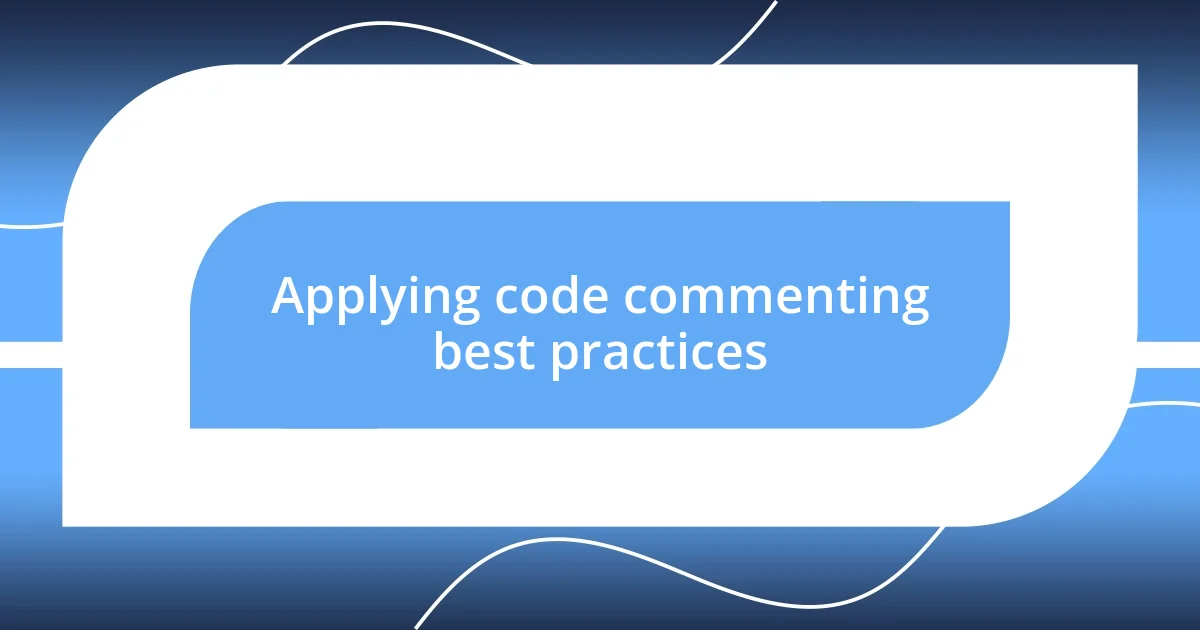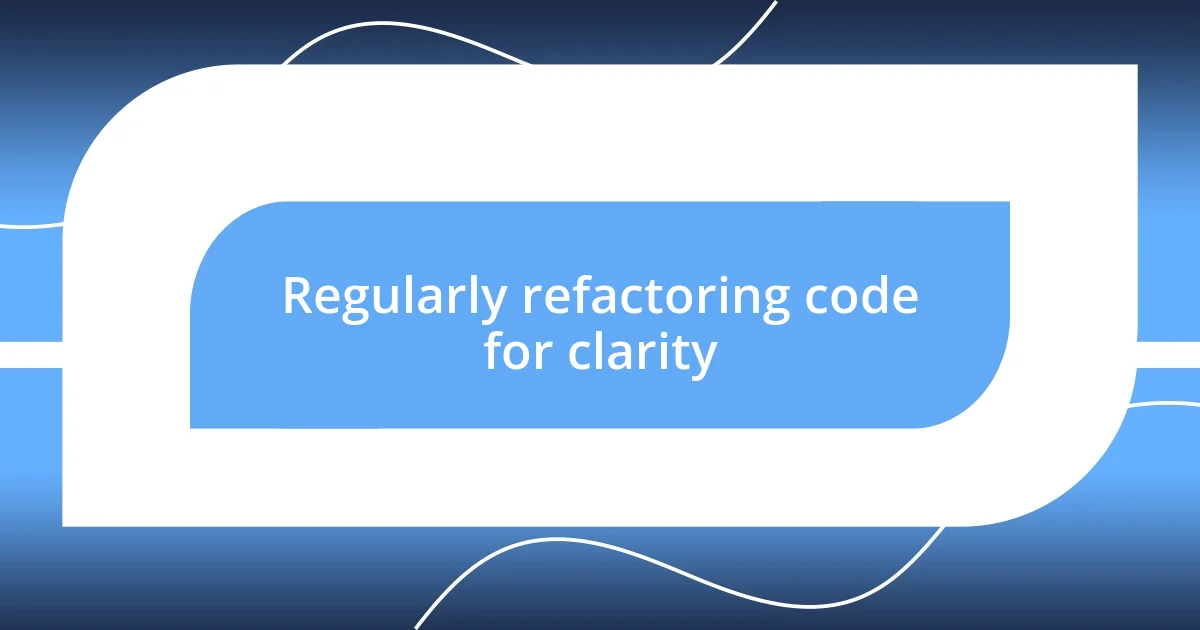Key takeaways:
- Clean code principles emphasize readability and maintainability, which enhance collaboration and reduce debugging time.
- Consistent naming conventions and modular code structure greatly improve code clarity, making it easier to understand and work with.
- Regular refactoring and incorporating linting tools into workflows help maintain code quality and prevent future complications.

Understanding clean code principles
Clean code principles focus on writing code that is easy to read and maintain, which is crucial in any development process. I remember one project where the codebase was so cluttered that debugging felt like searching for a needle in a haystack. It made me wonder how many developers faced similar frustrations when dealing with overwhelming code.
One of the key ideas behind clean code is that it should reveal its intent clearly. For instance, when I refactor my code, I pay special attention to naming conventions. Naming variables and functions descriptively saves time later; it allows anyone picking up the code to immediately grasp what each piece does. Don’t you find it much easier to work with code that communicates its purpose?
Understanding these principles profoundly changes not only how we write code but also how we collaborate. I’ve often felt the satisfaction of reading someone else’s clean code, and it’s like having a friendly guide through a complex maze. Doesn’t that make you think about the impact your coding style can have on others?

Importance of code readability
Code readability is more than just a preference; it’s a foundation for effective collaboration and long-term maintenance. I’ve been in situations where I inherited a codebase with minimal documentation and poor structure. The confusion was palpable. In those moments, I realized that a well-organized and readable codebase fosters collaboration, letting me and my team quickly grasp the functionality and purpose of the code. This understanding not only reduces the mental fatigue of deciphering someone else’s work but also empowers us to innovate and improve.
Here are some reasons why code readability is essential:
- Ease of Maintenance: Clean, readable code simplifies the process of identifying and fixing bugs.
- Team Collaboration: Teams can share the workload without extensive onboarding, leading to efficient project progression.
- Future Scalability: Readable code paves the way for easy extensions or modifications, ensuring adaptability to future requirements.
- Reduced Errors: When code is intuitive, the likelihood of mistakes diminishes, saving time and resources.
- Knowledge Transfer: Clear code allows new team members to understand the existing code quickly, easing the transition.
Each of these points resonates with my experience, making me appreciate the impact of readability on the overall development process. When I see clean, readable code, it feels like finding a well-marked trail in an otherwise dense forest; it gives me confidence to move forward without second-guessing every step.

Implementing consistent naming conventions
Implementing consistent naming conventions
Choosing the right naming conventions is like picking the right labels for a set of drawers. I vividly recall a project where I started with vague variable names like temp and data, which quickly led to chaos. As I refactored, switching to descriptive names like currentTemperature and userData, everything clicked into place. Isn’t it remarkable how such a simple shift can clarify your code, making it feel like a breath of fresh air?
Consistency is another crucial factor in naming conventions. When I decided to follow established patterns—like using camelCase for variables and PascalCase for classes—I noticed a profound improvement in how intuitively the code flowed. Colleagues on my team mentioned how this alignment made reviewing pull requests far less time-consuming. Have you ever experienced the satisfaction of navigating through code seamlessly due to uniform naming? It certainly makes a positive difference.
Moreover, it’s important to keep the context in mind while naming. During a recent project, I struggled with naming several functions that processed user input. Finally, I settled on validateEmailInput and sanitizeUserInput, which instantly conveyed their purpose. By investing time upfront into naming, I saved countless hours later on during debugging. When we put thought into our naming conventions, we create an almost self-documenting codebase that speaks volumes about our intentions.
| Naming Convention | Description |
|---|---|
| CamelCase | Used for variables and functions (e.g., userProfile, fetchData) |
| PascalCase | Used for classes and components (e.g., UserProfile, DataFetcher) |
| snake_case | Often found in databases or APIs (e.g., user_profile, fetch_data) |
| kebab-case | Common in URL slugs or CSS classes (e.g., user-profile, fetch-data) |

Utilizing modular code structure
Utilizing a modular code structure has changed the way I approach complex projects. When I first embraced this methodology, I remember feeling overwhelmed by tangled, monolithic code files that felt like an impenetrable labyrinth. After transitioning to a modular approach, breaking the code into smaller, self-contained modules became a game changer; I often liken it to organizing a messy closet into neatly labeled bins. Doesn’t it feel infinitely easier to navigate a project when each piece has a clear purpose and boundary?
Each module serves a specific function, making it simple to test and debug. I had a project where a single feature was causing all sorts of headaches. By isolating it into a dedicated module, I reduced both the time and energy spent on troubleshooting. That experience reinforced my belief in modularization: it not only enhances readability but also increases the reusability of code across different projects. Have you ever experienced the lightbulb moment of realizing a module could be reused elsewhere? It’s like finding a hidden gem in your own work!
Creating a modular structure also fosters collaboration within a team. I’ve witnessed how splitting responsibilities by module can lead to less overlapping work, allowing teammates to specialize without stepping on each other’s toes. When we each have a distinct module to focus on, the synergy is palpable—it’s like an orchestra playing in harmony. Looking back, I can’t stress enough how this approach has not only streamlined my workflow but also enhanced our ability to innovate together. Isn’t that what every development team seeks?

Applying code commenting best practices
Applying best practices in code commenting can dramatically improve the readability and maintainability of your JavaScript projects. I often think of comments as signposts in the code—they guide you and others to understand what’s happening quickly. For instance, I once worked on a legacy codebase that was virtually devoid of comments. It felt like driving through an unfamiliar city without any road signs. After adding clear comments explaining the logic behind challenging pieces of code, it became so much easier for the whole team to contribute and navigate the project.
Moreover, I find that the best comments are those that explain why something is done, rather than what it does. A while back, I encountered a particularly convoluted algorithm that was well-written but had no explanation. When I finally deciphered its purpose, I realized that without context, it could easily confuse the next developer. Since then, I’ve made it a point to clarify the reasoning behind complex sections, often reflecting on how future me might need that extra insight. It raises the question: wouldn’t you prefer working in an environment where you always know the thought process behind the code?
Finally, I believe in striking a balance; too many comments can clutter the code like excessive annotations in a textbook. There’s a project I recall, where the developer felt compelled to comment every single line. While their intentions were good, it made the code overwhelming—I often found myself sifting through comments just to understand the logic flow. I now aim for concise, meaningful comments that add real value. What do you think? Finding that sweet spot between clarity and conciseness can truly transform your coding experience.

Incorporating linting tools in workflows
Incorporating linting tools into my development workflow has been a game changer for maintaining clean code. I remember the days when I’d manually search for syntax errors, often losing precious time debugging simple issues. With tools like ESLint, I’ve experienced the joy of catching potential errors early on, almost like having a trusty co-pilot guiding me through the coding sky. Isn’t it reassuring to know that your code adheres to established standards before you even push it to production?
One memorable project involved integrating a linting tool into a legacy codebase that had become chaotic over time. The moment I set it up, the immediate feedback on code quality was eye-opening. I had a good laugh when the linter flagged variable names that were less than descriptive. It was an embarrassing, yet enlightening, revelation about how easy it can be to overlook the readability of my own work. I often wonder: how many potential blockers could we avoid by simply understanding the importance of clean, linted code?
I’ve also made it a habit to configure linting rules that align with my project’s goals. This customization ensures that I’m not just following arbitrary standards but rather, I’m cultivating an environment that reflects my team’s style and preferences. The first time I tailored the rules to fit our needs, I felt empowered—like I was crafting a personalized toolkit. How often do we get the chance to take ownership of our coding practices while boosting team productivity? For me, it’s a win-win.

Regularly refactoring code for clarity
Regularly refactoring code is something I genuinely enjoy because it brings clarity to what could otherwise become convoluted messes. There was this one instance where I stumbled upon a section of logic that had grown complex over time, making it an overwhelming task to decipher. After dedicating a couple of hours to refactor it, I felt like I was peeling away the layers of an onion until the core message was clear. Have you ever felt that sense of accomplishment when something goes from chaos to clarity?
For me, the process of refactoring is like spring cleaning for my code. I take a step back and re-evaluate not only the functionality but also the intent behind each piece. I once had a function that had evolved so much it began to resemble a Swiss Army knife, serving too many purposes at once and confusing everyone in the process. After breaking it down into smaller, single-purpose functions, I found teammates not only understood it better but also felt more comfortable making changes. How liberating is it when a once-daunting codebase becomes manageable and inviting?
Ultimately, I believe refactoring should be a regular part of our coding routine, not an afterthought. It’s easy to push off refactoring until “later,” but I’ve learned from experience that waiting just invites more complications. I aim to treat refactoring like tuning a musical instrument; a little adjustment can make a world of difference. Imagine the improvement in collaboration and efficiency when we continually keep our codebase clean! Isn’t it worth investing that time now to ensure a smoother ride down the road?














